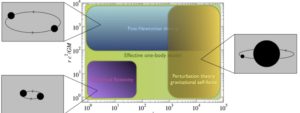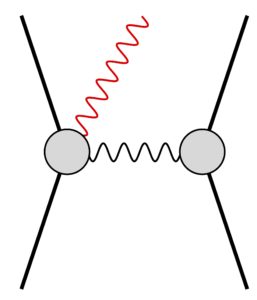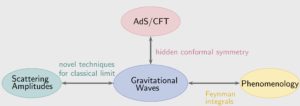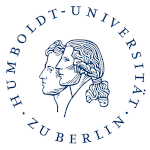Principal investigators: Alessandra Buonanno, Peter Marquard, Jan Steinhoff, Jan Plefka
Postdoctoral researcher: Gustav Uhre Jakobsen
Doctoral researcher: Kathrin Stoldt, Raj Patil
A spectacular success in fundamental physics has been the first observation of a gravitational wave (GW) from a binary black hole in 2015, and ten more GW observations with the LIGO/Virgo detectors since then. Seminal theoretical groundwork was crucial to detect and interpret those events. Theoretical work synergetically combines GW predictions from analytical (approximate, but fast) and numerical (exact, but slow) methods to solve the Einstein equations.

The effective-one-body (EOB) theory provides such a synergetic framework. It successfully provides LIGO/Virgo data analysts with accurate waveforms to detect GWs and infer astrophysical and cosmological properties from them.
Still, it is urgent to improve current EOB waveform models to cover accurately the entire binary parameter space and include all physical effects: higher-precision waveforms are needed to match the capabilitites of GW detectors in a decade from now. Thus, it is critical and timely to rethink the theoretical modeling of GWs and the relativistic two-body problem.
A very promising direction is to make use of modern techniques for scattering amplitudes: on-shell variables, generalized unitarity, and color-kinematics duality. The link from amplitudes to the (classical) gravitational potential of binary black holes has been explored—as an expansion in the gravitational coupling G—using eikonal limits and an effective-field-theory matching:

This line of research culminated (so far) in the calculation of the interaction potential of two black holes at third order in the gravitational coupling by Bern and collaborators [GW1,GW2].
Going beyond conservative potentials, an extension to dissipative effects (GWs leaving the binary) is the crucial next step to build consistent GW models based on scattering amplitudes. Another key question emerging is to what extent the double-copy/color-kinematic duality exists beyond the realm of quantum scattering amplitudes and can beneficially be applied to GW physics.
is the crucial next step to build consistent GW models based on scattering amplitudes. Another key question emerging is to what extent the double-copy/color-kinematic duality exists beyond the realm of quantum scattering amplitudes and can beneficially be applied to GW physics.
Integration into the RTG

Approaching GW physics from a QFT perspective is highly topical and can drive many innovations: isolating the classical part of scattering amplitudes (enabling efficient applications of modern scattering amplitude techniques), unveiling a hidden (dual) conformal symmetry in the EOB Hamiltonian, and formulating analytic approximation methods for GWs in terms of Feynman integrals.

